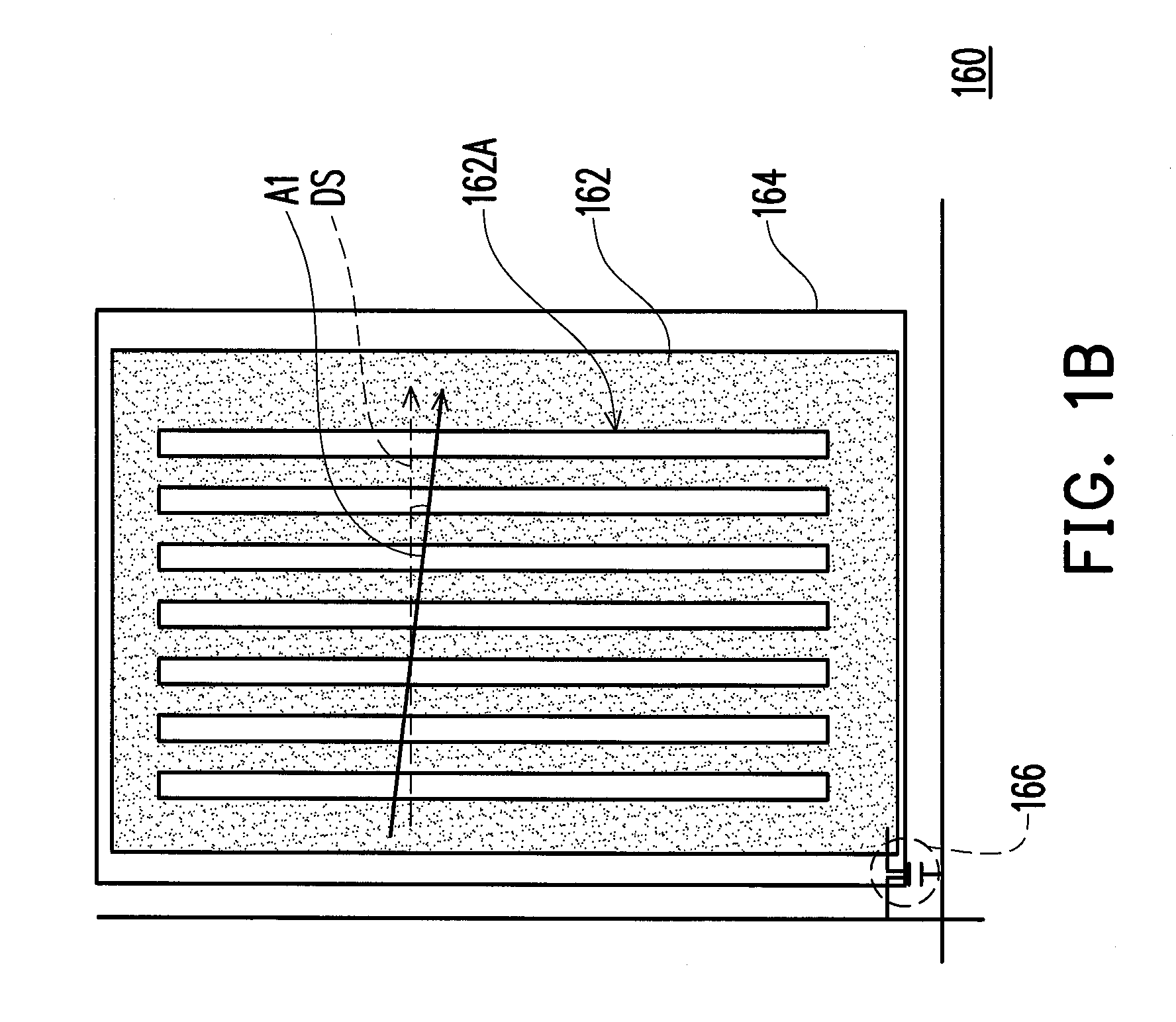Liquid crystal display panel
a liquid crystal display and panel technology, applied in optics, instruments, non-linear optics, etc., can solve problems such as color shift and color washout, and achieve the effects of wide viewing angle display, desirable efficiency, and fast response speed
- Summary
- Abstract
- Description
- Claims
- Application Information
AI Technical Summary
Benefits of technology
Problems solved by technology
Method used
Image
Examples
first embodiment
[0028]FIG. 1A is a schematic cross-sectional view illustrating a portion of an LCD panel according to the invention, while FIG. 1B is a schematic top view illustrating an individual pixel structure in the LCD panel depicted in FIG. 1A. With reference to FIG. 1A and FIG. 1B, the LCD panel 100 includes a first substrate 110, a second substrate 120, a PSA liquid crystal layer 130, a first alignment layer 140, a second alignment layer 150, and a plurality of pixel structures 160. Here, only one of the pixel structures 160 is illustrated for explanation, while the number of the pixel structures 160 is plural in the actual design of the LCD panel 100.
[0029]The second substrate 120 is opposite to the first substrate 110 in this embodiment. The PSA liquid crystal layer 130 is configured between the first substrate 110 and the second substrate 120, and liquid crystal molecules 132 of the PSA liquid crystal layer 130 are substantially arranged in parallel to the first substrate 110 and the se...
second embodiment
[0037]In said embodiment, the area occupied by the first common electrode 164 substantially identical to the display area of the entire pixel structure 160 is exemplarily described, while the invention is not limited thereto. FIG. 2 is a schematic cross-sectional view illustrating a portion of an LCD panel according to the invention. With reference to FIG. 2, the LCD panel 200 includes a first substrate 110, a second substrate 120, a PSA liquid crystal layer 130, a first alignment layer 140, a second alignment layer 150, and a pixel structure 260. The relative correlation of these components can be learned from the explanation in the previous embodiment, and therefore no other descriptions are provided herein. The main difference between the LCD panel 100 and the LCD panel 200 of this embodiment lies in that the first common electrode 264 of the pixel structure 260 has a specific pattern and is made of at least one bar-shaped portion 264A. Each of the bar-shaped portions 264A is loc...
sixth embodiment
[0046]The design of the pixel structure is not limited to those described above. FIG. 6A is a schematic cross-sectional view illustrating a portion of an LCD panel according to the invention, while FIG. 6B is a schematic top view illustrating an individual pixel structure in the LCD panel depicted in FIG. 6A. With reference to FIG. 6A and FIG. 6B, the LCD panel 600 includes a first substrate 610, a second substrate 620, a PSA liquid crystal layer 630, a first alignment layer 640, a second alignment layer 650, and a plurality of pixel structures 660. Here, only one of the pixel structures 660 is illustrated for explanation, while the number of the pixel structures 660 is plural in the actual design of the LCD panel 600.
[0047]The second substrate 620 is opposite to the first substrate 610 in this embodiment. The PSA liquid crystal layer 630 is configured between the first substrate 610 and the second substrate 620, and liquid crystal molecules 632 of the PSA liquid crystal layer 630 a...
PUM
| Property | Measurement | Unit |
|---|---|---|
| Angle | aaaaa | aaaaa |
| Angle | aaaaa | aaaaa |
| Angle | aaaaa | aaaaa |
Abstract
Description
Claims
Application Information
 Login to View More
Login to View More - R&D
- Intellectual Property
- Life Sciences
- Materials
- Tech Scout
- Unparalleled Data Quality
- Higher Quality Content
- 60% Fewer Hallucinations
Browse by: Latest US Patents, China's latest patents, Technical Efficacy Thesaurus, Application Domain, Technology Topic, Popular Technical Reports.
© 2025 PatSnap. All rights reserved.Legal|Privacy policy|Modern Slavery Act Transparency Statement|Sitemap|About US| Contact US: help@patsnap.com



